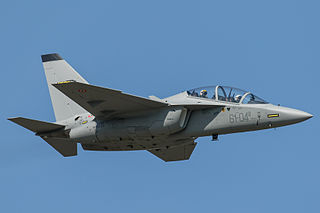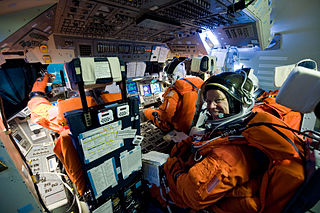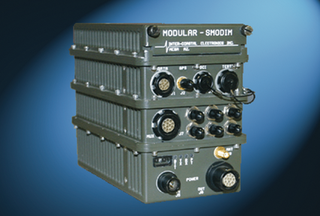
A flight simulator is a device that artificially re-creates aircraft flight and the environment in which it flies, for pilot training, design, or other purposes. It includes replicating the equations that govern how aircraft fly, how they react to applications of flight controls, the effects of other aircraft systems, and how the aircraft reacts to external factors such as air density, turbulence, wind shear, cloud, precipitation, etc. Flight simulation is used for a variety of reasons, including flight training, the design and development of the aircraft itself, and research into aircraft characteristics and control handling qualities.

The LTV A-7 Corsair II is an American carrier-capable subsonic light attack aircraft manufactured by Ling-Temco-Vought (LTV) to replace the Douglas A-4 Skyhawk. Its airframe design is a somewhat smaller version of the supersonic Vought F-8 Crusader. The Corsair II initially entered service with the United States Navy (USN) during the Vietnam War. It was later adopted by the United States Air Force (USAF), including the Air National Guard (ANG), to replace the Douglas A-1 Skyraider and North American F-100 Super Sabre. The aircraft was also exported to Greece in the 1970s, and to Portugal in the late 1980s. The USAF and USN retired the type in 1991, the ANG in 1993, the Portuguese Air Force in 1999, and the Hellenic Air Force in 2014.

The Aero L-39 Albatros is a high-performance jet trainer developed in Czechoslovakia by Aero Vodochody. It was designed during the 1960s as a replacement for the Aero L-29 Delfín as a principal training aircraft. The L-39 Albatros has the distinction of being the first of the second-generation jet trainers to be produced, as well as being the first trainer aircraft to be equipped with a turbofan powerplant. The type was exported to a wide range of countries as a military trainer.

Kirtland Air Force Base is a United States Air Force base located in the southeast quadrant of the Albuquerque, New Mexico urban area, adjacent to the Albuquerque International Sunport. The base was named for the early Army aviator Col. Roy C. Kirtland. The military and the international airport share the same runways, making ABQ a joint civil-military airport.

A trainer is a class of aircraft designed specifically to facilitate flight training of pilots and aircrews. The use of a dedicated trainer aircraft with additional safety features—such as tandem flight controls, forgiving flight characteristics and a simplified cockpit arrangement—allows pilots-in-training to safely advance their real-time piloting, navigation and warfighting skills without the danger of overextending their abilities alone in a fully featured aircraft.

The Pilatus PC-21 is a turboprop-powered advanced trainer with a stepped tandem cockpit. It is manufactured by Pilatus Aircraft of Switzerland.

The Alenia Aermacchi M-346 Master is a military twin-engine transonic trainer aircraft. Originally co-developed with Yakovlev as the Yak/AEM-130, the partnership was dissolved in 2000 and Alenia Aermacchi proceeded to separately develop the M-346 Master, while Yakolev continued work on the Yakovlev Yak-130. The first flight of the M-346 was performed in 2004. The type is currently operated by the air forces of Italy, Israel, Singapore, and Poland. Since 2016 the manufacturer became Leonardo-Finmeccanica as Alenia Aermacchi merged into the new Finmeccanica, finally rebranded as Leonardo in 2017.
A Naval Flight Officer (NFO) is a commissioned officer in the United States Navy or United States Marine Corps who specializes in airborne weapons and sensor systems. NFOs are not pilots per se, but they may perform many "co-pilot" functions, depending on the type of aircraft. Until 1966, their duties were performed by both commissioned officer and senior enlisted naval aviation observers (NAO).
Combat flight simulators are simulation video games used to simulate military aircraft and their operations. These are distinct from dedicated flight simulators used for professional pilot and military flight training which consist of realistic physical recreations of the actual aircraft cockpit, often with a full-motion platform.

The Shuttle Training Aircraft (STA) was a NASA training vehicle that duplicated the Space Shuttle's approach profile and handling qualities, allowing Space Shuttle pilots to simulate Shuttle landings under controlled conditions before attempting the task on board the orbiter. The STA was also flown to assess weather conditions just prior to Space Shuttle launches and landings.

A Weapon Systems Officer is an air flight officer directly involved in all air operations and weapon systems of a military aircraft.

A bombsight is a device used by military aircraft to drop bombs accurately. Bombsights, a feature of combat aircraft since World War I, were first found on purpose-designed bomber aircraft and then moved to fighter-bombers and modern tactical aircraft as those aircraft took up the brunt of the bombing role.
Thales Training & Simulation Ltd. is a multinational company which manufactures simulators, including full flight simulators and military simulators, and provides related training and support services. It is a wholly owned subsidiary of the Thales Group.

Marine Medium Tiltrotor Training Squadron 204 (VMMT-204) is the MV-22 Osprey training squadron of the United States Marine Corps. Known as the "Raptors", the squadron was originally designated Marine Medium Helicopter Training Squadron 204 (HMT-204) to train new MV-22 pilots and was officially redesignated as VMMT-204 on June 10, 1999. They fall under the command of Marine Aircraft Group 26 (MAG-26) and the 2nd Marine Aircraft Wing.

The VT-86 SabreHawks, also known as Training Squadron 86, is an aircraft flight training squadron of the United States Navy.

The Shuttle Mission Simulator (SMS) consisted of two simulators in Building 5 and one simulator in Building 35 of Johnson Space Center. The fixed-base simulators included high-fidelity mockups of the flight deck of a Space Shuttle, as well as a low-fidelity mockup of the middeck. The facility in Building 5 was known as the Fixed Base Simulator (FBS), while the facility in Building 35 was known as the GNS. The motion-base simulator consisted of the forward part of the flight deck of the Space Shuttle. It utilized a six-axis hexapod motion system with an additional extended pitch axis to provide motion cuing for all phases of flight.

Full flight simulator (FFS) is a term used by national (civil) aviation authorities (NAA) for a high technical level of flight simulator. Such authorities include the Federal Aviation Administration (FAA) in the United States and the European Aviation Safety Agency (EASA).

The Smart Onboard Data Interface Module (SMODIM) is used by the United States Army and foreign militaries for live simulated weapons training on military platforms. The SMODIM is the primary component of the Longbow Apache Tactical Engagement Simulation System that provides weapons systems training and collective Force-on-Force live training participation.
Unmanned aircraft system simulation focuses on training pilots to control an unmanned aircraft or its payload from a control station. Flight simulation involves a device that artificially re-creates aircraft flight and the environment in which it flies for pilot training, design, or other purposes. It includes replicating the equations that govern how aircraft fly, how they react to applications of flight controls, the effects of other aircraft systems, and how the aircraft reacts to external factors such as air density, turbulence, wind shear, cloud, precipitation, etc.


















